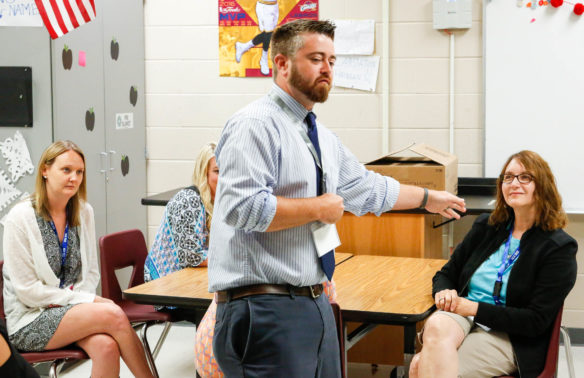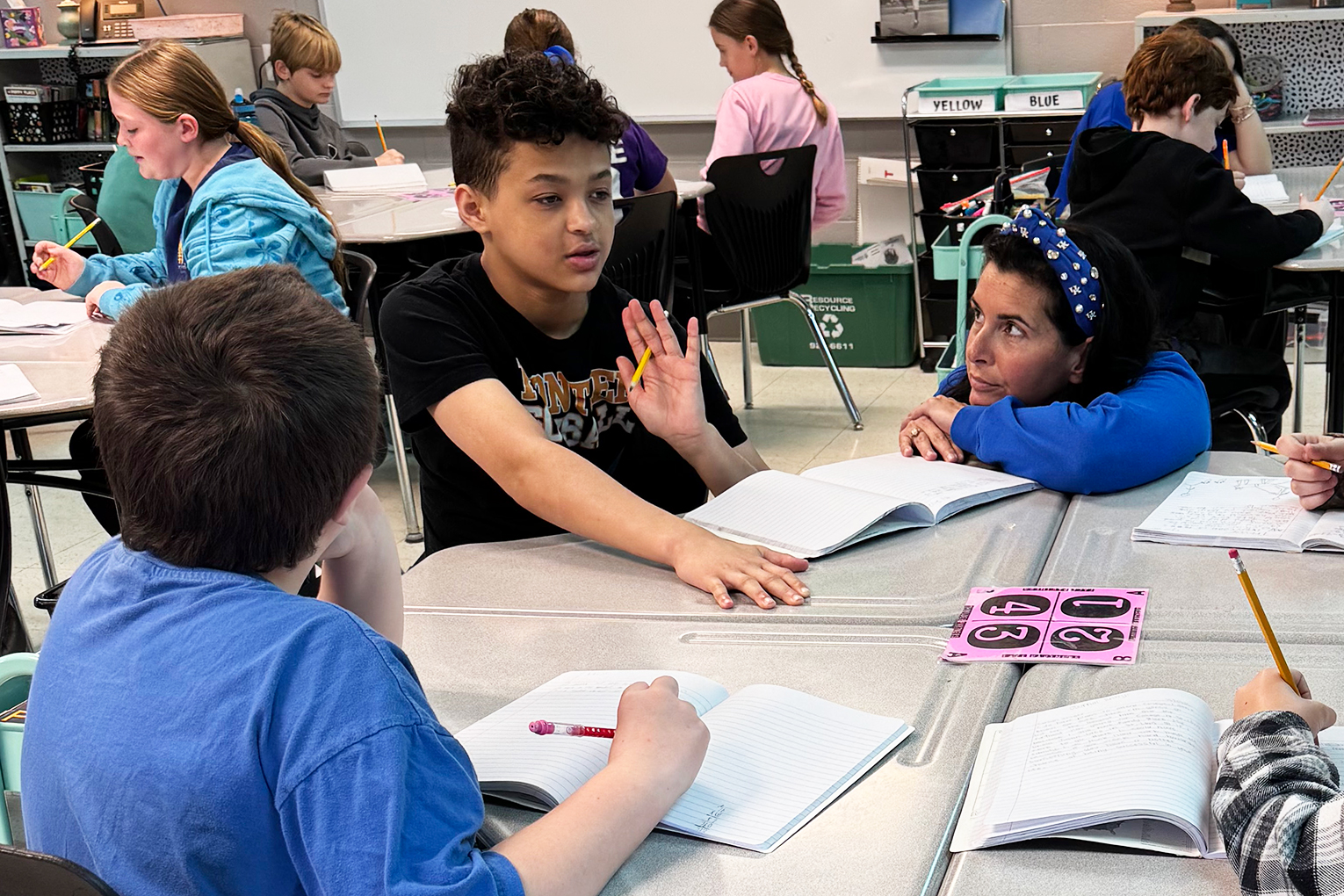
Brandon Hensley, an 8th-grade language arts teacher at Southern Middle School (Pulaski County), has developed a staged-discipline plan that has been proven to lower the numbers of referrals at his school. Hensley presented the discipline plan, which is designed to keep students in the classroom, in June at the Let’s TALK: Conversations about Effective Teaching and Learning Conference in Lexington.
Photo by Mike Marsee, June 13, 2017
By Brenna R. Kelly
Brenna.kelly@education.ky.gov
When students are sent to in-school suspension for behavioral problems, they might be getting instruction, but it’s not same instruction they would be getting in their classes.
Brandon Hensley, an 8th-grade language arts teacher at Southern Middle School (Pulaski County), recalled one student who served 36 days of in-school suspension (ISS) in one year.
“He missed 36 days of class, and not just one class; he missed 36 days of six classes,” he said. “That’s a big deal. We don’t look at it as an absence when they are in ISS, but it’s the same thing essentially because that student is not getting the kind of education they would get in the classroom.”
Managing student conduct has become a concern for teachers across the state. In the 2017 Teaching, Empowering, Leading and Learning (TELL) Survey completed by 91 percent of Kentucky’s teachers, 74 percent of teachers said they agreed that students follow rules of conduct at their school. Compared to 2015, that rate of agreement was down 4.8 percentage points – the biggest drop of any question in the survey.
All eight questions about student conduct saw a drop in rate of agreement over 2015, which made the category the only one with a total decrease in the agreement rate.
Hensley believes a staged-discipline plan he developed more than 10 years ago could help teachers deal with the small but persistent discipline issues that often lead to students missing class for ISS.
Hensley presented the discipline plan in June at the Let’s TALK: Conversations about Effective Teaching and Learning Conference in Lexington.
“This just started in one little classroom. I did it for a year and I was like, ‘Wow, this really works,’” he said. “You could have this implemented this year in your class or even schoolwide.”
Hensley’s plan, called the Hensley Model of Team-based Discipline, is a five-step system students move through as they continue to disobey the rules, he said. The idea is to give students clear rules to follow and clear consequences for when they aren’t followed.
In addition to consequences, there must be rewards for positive behavior, said Hensley, who also is the school’s Positive Behavioral Interventions and Supports (PBIS) coach. Students at Southern Middle use ARROW cards, which stand for Accountability, Respect, Responsibility, Obey the rules and Winning attitude. Teachers sign one of the letters for a student when they see them displaying one of those behaviors, then students turn the cards into the office. At the end of the nine weeks, the school holds a party for all the students who have their cards signed in all categories.
“Even some of the kids who you don’t think can get all of those are out working hard to get those cards signed, because they know that’s the only opportunity they have to get something like that,” said Jeremy Cole, choral music director at Southern Middle, who attended the conference.
But when students aren’t following the rules, that’s when teachers use Hensley’s plan.
The first time a student breaks the rules the teacher gives a verbal warning, Hensley said. For the second offense, students get a discipline card. The card has three carbon copies – one for the teacher to sign, one for the parents to sign and one for the student to keep
“It’s not an office referral, it’s more of a heads-up,” Hensley said. The card has to be signed by all of the student’s other teachers and his or her parents.
For the third infraction, the teacher calls the student’s parents and explains that this is the student’s third time getting in trouble. Hensley also tells the parents that their child is getting close to an office referral, which will stay on his or her record.
The fourth time a student gets into trouble they go into “Team Safe.”
“My kids beg to go to the office, to go to ISS, because they don’t want to stay in Team Safe,” Hensley said.
When a student is in Team Safe, they have a special seat in each class, a designated place to stand in the hallway between classes, must eat lunch alone and can only talk to the teacher the entire day.
Every day the teachers get a list of the students two are in Team Safe. Students can talk to other students only during group work, he said.
“The whole goal is to have them in class learning and not sitting in ISS,” Hensley said.
To get out of Team Safe, students have to be 100 percent compliant with school and classroom rules and be in good academic standing.
“If they have an F, we don’t let them out of Team Safe until they have a D,” he said. “They are not getting out until everything is right. And for most kids, three days and everything is right.”
Using Team Safe gives teachers the power over their classroom, Hensley said, and frees up administrators to work on other issues. Also students dislike the isolation of Team Safe and the fact that all the other students know they are in trouble, he said.
“Once the first student gets in Team Safe at the beginning of the year, the other students will see that and your small discipline problems will drop like flies,” Hensley said.
But there are some students who will continue to get into trouble even after they get out of Team Safe, he said. Students get an office referral for the fifth infraction. The teacher and principal also hold a conference with the student’s parents.
“It takes five times for the student to mess up before they ever go down to the principal’s office,” Hensley said.
And by that time, the teacher has documentation of the student’s behavior through the four infractions.
“The teacher can say to the administrator, ‘Back me up, help me out with this kid,’” he said. “’Look at what I’ve already done.’”
If a student does get ISS they must stay in Team Safe for three more days when they return to the classroom.
Office referrals at Southern Middle School (Pulaski County) after implementing the Hensley Model of Team-based Discipline
Source: SWIS Suite student behavior database from Brandon Hensley
Robert Meacham, the Kentucky Department of Education’s PBIS program manager, said a plan that focuses on encouraging positive student behaviors can lead to improved student achievement.
“A schoolwide approach to classroom behavior that focuses on clear expectations across settings, positive student-teacher engagement and reinforcement of appropriate behavior has a powerfully positive effect on achievement,” he said. “When teachers are empowered with strategies to positively engage student behaviors, success is not far behind.”
After Hensley started using the plan in his class, he expanded it to include his four-teacher team, then two teams starting using it, then half the school. Finally in the 2016-17 school year, Hensley’s discipline plan was used schoolwide.
The school has seen a 59.7 percent reduction in number of office referrals over the past four years as the plan was rolled out across the student body, Hensley said. In the first year of schoolwide use, there was an 81 percent reduction in the number of referrals among the population of students who had referrals the prior year, he said.
Teachers can adapt the strategy to fit their code of conduct and decide on their own what constitutes an infraction, he said. But both teachers and administrators should agree to stick with the plan.
“Be consistent, stick to the plan, have clear rules for the students to follow,” Hensley said. “This can change a student’s entire trajectory, and that’s what we’re after as teachers.”
MORE INFO …
Brandon Hensley Brandon.Hensley@pulaski.kyschools.us




I checked the demographics for this school district. Is it still 95% white? An urban school with a racially diverse population could have a very different outcome.